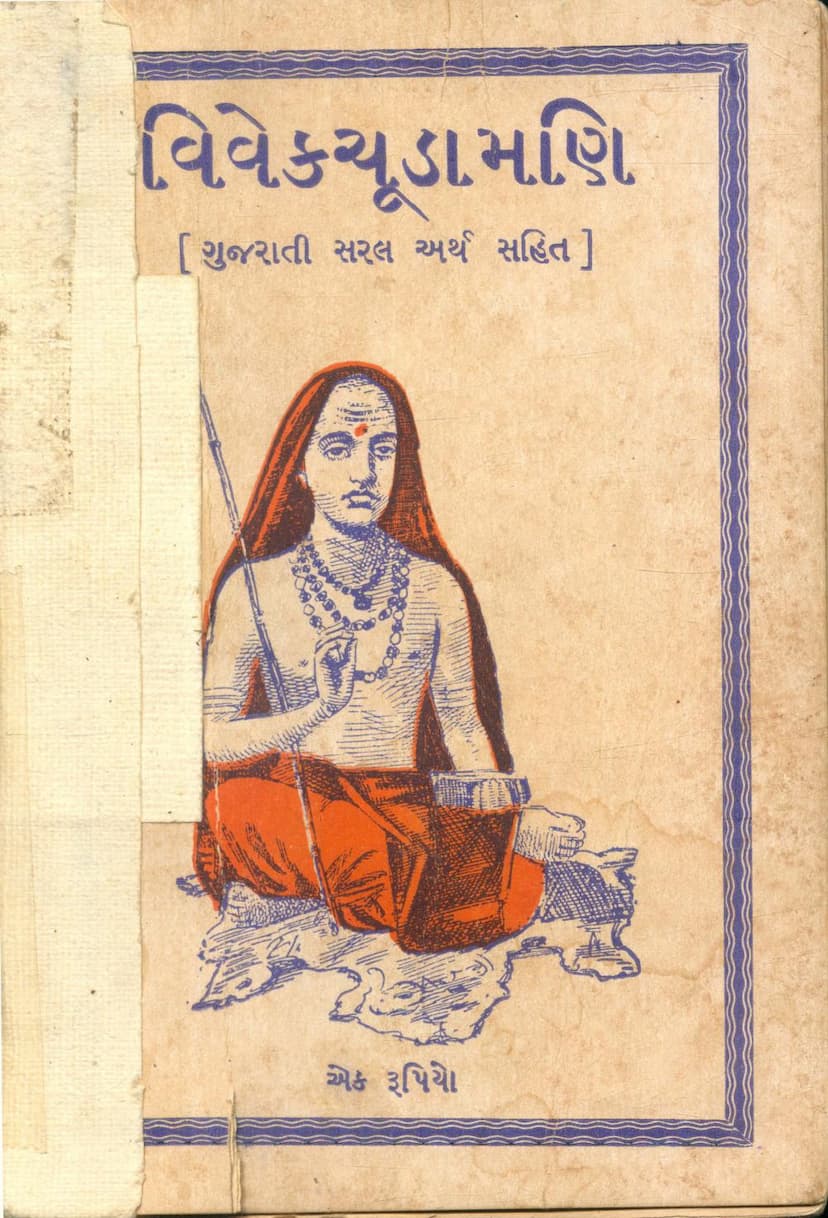Vivek Chudamani Gujarati Saral Arth Sahit
Added to library: September 2, 2025

Summary
Here is a comprehensive summary of the Jain text "Vivek Chudamani Gujarati Saral Arth Sahit" by Devshankar Dave, published by Sastu Sahityavardhak Karyalay Mumbai:
Title: Vivek Chudamani Gujarati Saral Arth Sahit (A Crest Jewel of Discrimination with Simple Gujarati Meaning)
Author: Adi Shankaracharya (attributed) Gujarati Translator: Shastri Devshankar Dave Publisher: Sastu Sahityavardhak Karyalay Mumbai
Overall Theme:
"Vivek Chudamani" is a foundational text in Vedanta philosophy, attributed to the great sage Adi Shankaracharya. This Gujarati edition, with a simple and accessible translation by Shastri Devshankar Dave, aims to make the profound teachings of Vedanta understandable to a wider audience. The core message of the text revolves around viveka (discrimination between the real and unreal, the eternal and the transient) as the primary means to achieve moksha (liberation) from the cycle of birth and death.
Key Concepts and Structure:
The book is structured as a dialogue between a Guru and a disciple, where the disciple poses questions about the nature of reality, the self, and the path to liberation. The Guru then systematically expounds upon these topics, guiding the disciple towards self-realization.
The text emphasizes the following key concepts:
-
The Rarity and Importance of Human Life: The text begins by highlighting the extreme difficulty of obtaining a human birth, the purity of intention, and the association with a spiritual teacher. It underscores that a human life, especially one with the capacity for spiritual inquiry, is a precious opportunity that should not be wasted.
-
The Fourfold Means of Liberation (Sadhana Chatushtaya): The path to liberation is presented as requiring four essential qualifications:
- Nityanitya Vastu Viveka: Discrimination between the eternal (Atman/Brahman) and the non-eternal (the world of names and forms, the physical body, senses, etc.).
- Iha-Amutra Phala Bhoga Viraga: Renunciation of desire for the fruits of actions, both in this life and the next.
- Shat Sampatti (Six Treasures): This includes:
- Shama: Control of the mind.
- Dama: Control of the senses.
- Uparati: Cessation from worldly activities.
- Titiksha: Endurance of suffering.
- Shraddha: Faith in the scriptures and the Guru.
- Samadhana: Concentration of the mind.
- Mumukshutva: An intense longing for liberation.
-
The Nature of the Self (Atman) and Non-Self (Anatma): The text meticulously analyzes the different sheaths (koshas) that cover the true Self:
- The Gross Body (Sthula Sharira): Described as a collection of perishable elements and ultimately seen as an object of aversion rather than attachment.
- The Subtle Body (Sukshma Sharira): Comprising the senses, mind, intellect, ego, and the life-force (prana).
- The Causal Body (Karana Sharira): Associated with ignorance (avidya).
- Through discrimination, the disciple is led to understand that the true Self (Atman) is distinct from all these sheaths and is the eternal, unchanging, conscious essence, which is ultimately identical with Brahman.
-
The Role of the Guru: The importance of a qualified Guru is paramount. The Guru is depicted as the dispenser of wisdom, the embodiment of compassion, and the guide who illuminates the path to liberation. The disciple is urged to approach the Guru with humility, devotion, and a genuine desire to learn.
-
The Illusory Nature of the World (Jagat): The world is described as Maya – an illusion, a superimposed reality like a snake seen in a rope. It appears real due to ignorance but vanishes upon true knowledge.
-
The Identity of Atman and Brahman: The central realization is the oneness of the individual soul (Atman) with the Universal Consciousness (Brahman). This realization is not merely intellectual but an experiential understanding achieved through contemplation and meditation. The Mahavakyas (great sayings) from the Upanishads, such as "Tat Tvam Asi" (That Thou Art), are highlighted as key to this realization.
-
Liberation (Moksha): Liberation is defined as the cessation of ignorance and the realization of one's true nature as Brahman. It is not an external achievement but an internal awakening. The text distinguishes between liberation while living (Jivanmukti) and liberation after the body's demise (Videhamukti).
-
The Importance of Self-Effort: While guidance from a Guru and the scriptures is essential, the ultimate effort for liberation must come from the individual. The text strongly advocates for self-reflection and constant practice.
-
The Nature of Maya and its Three Gunas: The text delves into the concept of Maya, the creative power of Brahman, composed of the three gunas (Sattva, Rajas, and Tamas). It explains how these gunas create the perceived reality and bind the individual soul.
Gujarati Translation's Contribution:
The Gujarati translation by Shastri Devshankar Dave plays a crucial role in making the complex philosophical concepts accessible. The "Saral Arth Sahit" (with simple Gujarati meaning) ensures that the reader can grasp the nuances of Shankaracharya's teachings without getting lost in the intricacies of Sanskrit terminology. The publisher, Sastu Sahityavardhak Karyalay, is known for its mission to provide high-quality spiritual and religious literature at affordable prices, aligning with the accessibility aspect of this edition.
In essence, "Vivek Chudamani" is a guide for the sincere seeker who wishes to understand the nature of reality, discern the eternal from the temporal, and ultimately realize their innate divinity. This Gujarati edition serves as an invaluable tool for those seeking spiritual knowledge and liberation.